UH-34 DOWN IN THE SOUTH CHINA SEA
Bureau Number 145768
Capt. James E. Givan, Pilot
(Survived the crash)
2ndLt. William T. Holmes,
Copilot (Survived the crash)
Sgt. Gerald V. Glenn
, Crew Chief (Survived the crash)
Cpl. John Thomas Corle,
Gunner
MAG-36 Command Chronology entry of 8 December 1965:
One HMM-364 aircraft, participating in a three aircraft administrative
flight from Da Nang to Chu Lai, suffered an engine failure at coordinates
BT 225550. The pilot made an autorotation into the surf. Upon
landing, large waves tipped the aircraft forward into an inverted position.
All four crew members were seen exiting the downed aircraft by one of the
pilots of the other aircraft. These aircraft proceeded to rescue
the two pilots first because they were in the heaviest surf. The
lead aircraft by this time was in a position to rescue the crew chief (the
gunner was seen again after his exit from the aircraft), but was unable
to lift the man out of the water due to an inoperative rescue hoist.
In a heroic, desperate and successful attempt to save the man, the gunner
in the aircraft hung by his legs from the landing gear and held the man
partially out of the water until the wing aircraft was in position for
a hoist pick up. As the hoist was being commenced by the other aircraft,
the rescue sling broke. The man was able to hold fast to the remnants
of the sling while the pilot air taxied to the beach. Both aircraft
landed on the beach and the crew chief of the lead aircraft removed its
mounted M-60 machine guns, set them up on the beach and returned the fire.
The pilot of the wing aircraft turned its tail toward the tree line and
thus allowed both his crew chief and gunner to utilize their M-60s for
return fire without removing them from the aircraft. After the enemy
fire was suppressed, both aircraft proceeded to search for the lost gunner.
However, a low fuel state forced them to return to Ky Ha with negative
results. Two aircraft committed to MAG-12 for SAR duty were later
utilized to search for the gunner but were forced to abandon the search
when intense enemy small arms fire was again encountered. One of
the aircraft received a hit as a result of this fire.
Expanded Narrative as Recalled by Members of the Flight
On the morning of December 8, 1965, Cpl. Corle was
assigned as gunner on a logistical mission which by all of its attributes
should have been a non-event. Cpl. Corle's aircraft was one of three
which were assigned to fly a logistical mission from Ky Ha to Da Nang,
47 miles up the coast, and return. The crew of the aircraft were
Capt. Jim Givan, pilot; 2ndLt. William T. "Tee" Holmes, Jr., copilot; and
Sgt. Gerald V. Glenn ,crew chief. It was 2ndLt. Holmes' first flight
in Vietnam and this "milk run" type mission was the standard way to get
new pilots familiar with maps, radio frequencies and flight procedures
before flying on real combat missions.
It was a miserable day with rain and fog which dictated
that the flight of three UH-34's would do a little "scud running" and zip
right up the coastline. They would have to fly low over the seacoast
to stay under the clouds. But they reasoned they could remain far
enough out over the ocean to avoid possible ground fire.
The flight of three, Cpl. Corle's aircraft was tail-end-charlie,
took off from Ky Ha, flew over the steep cliff at the seashore, and
then rotored northward toward Da Nang. The weather quickly turned
rotten. A gale was brewing, and the wind swept in from the open sea
at about 35 knots. Visibility fell to a couple of miles in rain,
and there was a hard overcast about 500 feet above the surface of the ocean.
Yet, except for the lousy weather the flight to Da Nang was uneventful.
The three helicopters landed at the depot at Da Nang,
shut down their engines, and the crew chiefs, gunners and 2ndLt. Holmes
started loading the supplies. These items consisted of about 80 cases
of beer, plus helicopter spare parts and a variety of helicopter maintenance
equipment. Then they fired up their radial engines, engaged their
rotors and took off for Ky Ha.
As the flight progressed out over the South China Sea
the weather really turned sour. Forward visibility had decreased
to about a mile in rain and fog, and the cloud layer constituting a ceiling
had dropped to about 200 feet above the sea. Still, the three helicopters
managed to stay VFR as they skimmed along above the waves. The crew
felt no cause for alarm. Nothing could go wrong, they reasoned.
On Cpl. Corle's aircraft the crew kept up a sarcastic running chatter over
the ICS system about the "beautiful" weather.
The TACAN (a bearing and distance navigation radio)
picked up mileage and heading to Chu Lai. By the pilot's calculations
they were somewhere near Tam Ky, and in roughly eight minutes they would
be back on the ground at Ky Ha. But unfortunately he was wrong, the
FM radio rasped, "Takin' fire from the beach!"
Exactly where the fatal round struck the helicopter,
no one knows. The H-34's engine suddenly died. No warning,
no cough, no sputter; it just quit. The abrupt and unexpected silence
seemed almost deafening. Capt. Givan keyed the FM radio, "MAYDAY!
MAYDAY!"
A UH-34 without engine power glides only slightly better
than a falling anvil. And with only 200 feet of altitude, Capt. Givan
had just a few precious seconds until impact with the water down below.
Down collective! Full right rudder! Harness locked! Jam the
cockpit escape hatches open! Here comes the water - - Flare! - -
Flare! - - Flare! The UH-34 hit the water hard, rolled inverted,
and began sinking toward the bottom of the sea. Under water in the
upside-down cockpit, the pilots remembered their dilbert-dunker training
from flight school at Pensacola. They yanked radio cords loose from
their flight helmets, unlatched lap and shoulder harness, squeezed through
the escape hatches and followed the air bubbles to the surface. The
pilots saw the waves were about eight feet high, the wind whipped stinging
salt spray across their faces and each time they topped a wave they could
see and hear enemy firing at them from a tree line on the beach.
 Fortunately
the other two UH-34's, (one piloted by 1stLt. Kenneth L. Gross and his
copilot 1stLt. Lenny Melancon; the other commanded by Capt.
Dick Gleason) had heard Capt. Givan's "MAYDAY." They circled
back, their gunners firing at the enemy muzzle flashes on the beach.
The Marines in the water did not know which threat was the greatest.
If they started waving their arms, they would attract more enemy fire from
the beach. But if they did not wave, their squadron mates might not
see them. Lt. Holmes would explain some years later that it became
an easy choice, "I waved and splashed like a maniac!"
Fortunately
the other two UH-34's, (one piloted by 1stLt. Kenneth L. Gross and his
copilot 1stLt. Lenny Melancon; the other commanded by Capt.
Dick Gleason) had heard Capt. Givan's "MAYDAY." They circled
back, their gunners firing at the enemy muzzle flashes on the beach.
The Marines in the water did not know which threat was the greatest.
If they started waving their arms, they would attract more enemy fire from
the beach. But if they did not wave, their squadron mates might not
see them. Lt. Holmes would explain some years later that it became
an easy choice, "I waved and splashed like a maniac!"
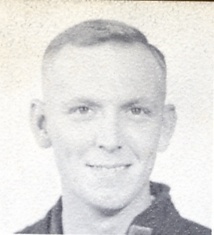
|
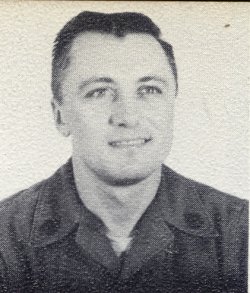
|
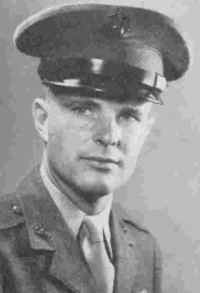
|
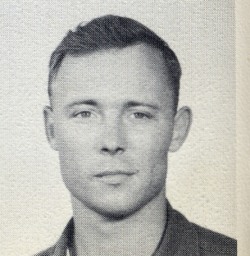
|
|
Lt. K. L. Gross
|
SSgt. Christman
|
Sgt. G. V. Glenn
|
Cpl. R. E. Cone
|
As the two UH-34's bored in, their crew chiefs kicked
out case after case of beer to lighten the load for the rescue. Lt.
Gross sighted the survivors in the water and with verbal assistance from
his crew chief, SSgt. Christman, was able to hoist Capt. Givan and Lt.
Holmes into his aircraft. The hoist went down a third time for Sgt.
Glenn. Once Sgt. Glenn was in the "horse collar" and ready to be
lifted, the hoist malfunctioned and would not retract. Disregarding
the enemy fire Lt. Gross' gunner, Cpl. Cone, crawled out onto the main
gear to assist Sgt. Glenn. Again with verbal instructions from SSgt.
Christman the helicopter was lowered within inches of the rolling waves.
Cpl. Cone wound his legs around the main strut and laid back inverted holding
on to Sgt. Glenn as the helicopter was air taxied toward the beach.
Upon reaching the beach SSgt. Christman manned Cpl. Cone's machine gun
to set a covering field of fire while Cpl. Cone assisted the beleaguered
Sgt. Glenn into the aircraft. The rescued crew advised Lt. Gross
that they were still missing one of their crew. The two helicopters
repeatedly circled and searched in vain for they never found the missing
gunner, and due to a low fuel state had to return to Ky Ha. The windswept
ocean had swallowed Corporal John Thomas Corle at UTM grid coordinates,
BT225550.
EPILOGUE
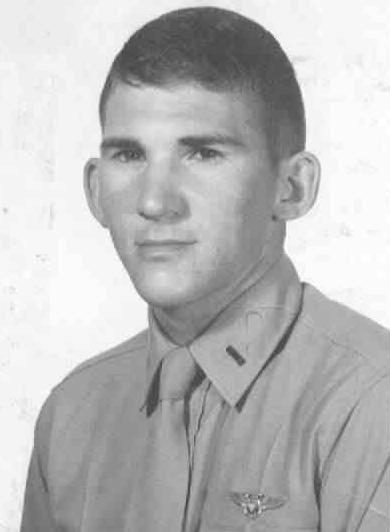 William
T. Holmes, Jr. supplies additional information on 26 February 1999.
"About all that I can add is that Cpl. Corle did make it out of the
aircraft. I think I was probably the last person to exit the helicopter
after it entered the water because I struggled for some time before I realized
I had not released my seat belt and shoulder harness. I was going
to the bottom with the aircraft. When I finally got out it was a
long way to the surface and it seemed an eternity to get there."
William
T. Holmes, Jr. supplies additional information on 26 February 1999.
"About all that I can add is that Cpl. Corle did make it out of the
aircraft. I think I was probably the last person to exit the helicopter
after it entered the water because I struggled for some time before I realized
I had not released my seat belt and shoulder harness. I was going
to the bottom with the aircraft. When I finally got out it was a
long way to the surface and it seemed an eternity to get there."
"Once at the surface, though we were scattered over
some distance and the high waves made it difficult to see anyone except
when they crested a wave while I was also riding the crest, I do remember
counting heads and I am sure that I saw all three of the other crew members.
We were not close enough to communicate with one another, nor could I determine
any one else's condition, but I am almost positive that all four of us
were on the surface."
"After that first sighting, I did not see any of
the other crew members until I saw Capt. Givan being raised on the hoist
of one of the rescue helicopters." Click
here
for additional comments of William T. Holmes.
Information provided by:
Bonnie-Sue A Marine Corps Helicopter
Squadron in Vietnam, by Marion F. Sturkey,
Heritage
Press International 1996, pp 13-16
William T. Holmes, Jr., former
Lieutenant USMCR
Kenneth L. "Uncle Harry" Gross,
Major USMC (Ret)
Vietnam Helicopter Pilots Association
MAG-36 Command Chronology of 8
December 1966
Robert E. Clark-Cone, former Cpl.
USMC
Robert W. Christman, SSgt. USMC
ADDITIONS, CORRECTIONS, COMMENTS REQUESTED
SLJNCO
LAST UPDATED: JUNE 9,
2000
HOME
 Fortunately
the other two UH-34's, (one piloted by 1stLt. Kenneth L. Gross and his
copilot 1stLt. Lenny Melancon; the other commanded by Capt.
Dick Gleason) had heard Capt. Givan's "MAYDAY." They circled
back, their gunners firing at the enemy muzzle flashes on the beach.
The Marines in the water did not know which threat was the greatest.
If they started waving their arms, they would attract more enemy fire from
the beach. But if they did not wave, their squadron mates might not
see them. Lt. Holmes would explain some years later that it became
an easy choice, "I waved and splashed like a maniac!"
Fortunately
the other two UH-34's, (one piloted by 1stLt. Kenneth L. Gross and his
copilot 1stLt. Lenny Melancon; the other commanded by Capt.
Dick Gleason) had heard Capt. Givan's "MAYDAY." They circled
back, their gunners firing at the enemy muzzle flashes on the beach.
The Marines in the water did not know which threat was the greatest.
If they started waving their arms, they would attract more enemy fire from
the beach. But if they did not wave, their squadron mates might not
see them. Lt. Holmes would explain some years later that it became
an easy choice, "I waved and splashed like a maniac!"




